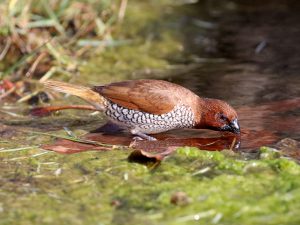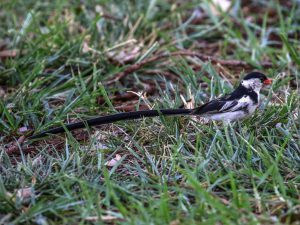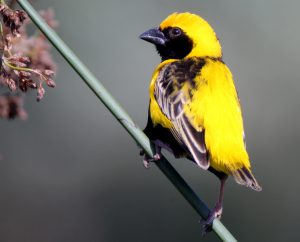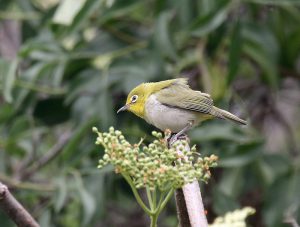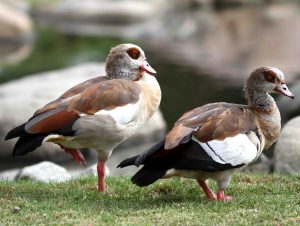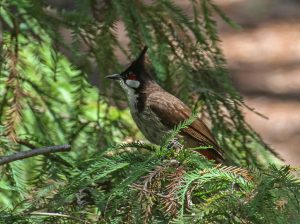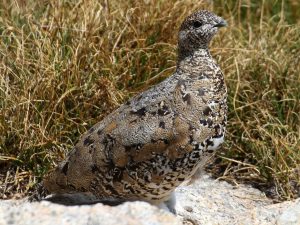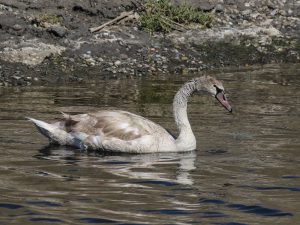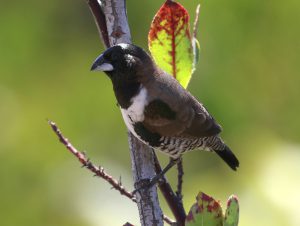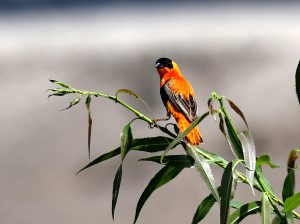Few subjects provoke the ire in a roomful of birders more rapidly than whether or not to count introduced species. The ins and outs of what is “countable”, what is “established”, and what is still an exotic alien has reddened faces and clenched fists among birders for decades. After that comes the discussion of which state bird records committee is loosest or tightest in their approach to exotics. By then, former friends begin to disperse faster than the young of the year.
But in the end, that is not really what matters here. When it comes to counting exotics, I find myself more and more adopting an eBird stance. That is: count them all, do it as accurately as possible, and submit your data. In the end, the importance of this goes far beyond a mere life list. What matters most is the impact that these growing populations of exotics have upon our native species and the environment in general. Make no mistake about it, that impact is huge.
The only way we will ever get any kind of handle upon it is to count each and every exotic species as accurately as possible and submit the data on eBird. Note that I treat eBird as an assumption here. Please do the following if you do not currently use eBird. Stop reading, open an account (http://ebird.org/) and download the app to your phone. Learn how to use it. Seriously. Then come back and finish reading.
Old Friends or Old Enemies?
You might think I exaggerate. I do not. Illegal avian aliens flourish in North America in numbers that are sometimes staggering. Start with the “big three”: House Sparrow, European Starling and Rock Pigeon. Right off the bat, this means millions of birds competing with native species for food and habitat resources. All three species reside in every lower 48 state and most of the Canadian provinces. Starlings, in particular, are rather nasty about usurping nest cavities from other species. These three species were all deliberately introduced back in the 19th century, some of them more than once when the initial release didn’t take hold! Beyond those three, a quick perusal of North American bird species shows at least 32 more introduced or exotic species. And that?s not counting any of the parrots and parakeets, which are another whole class by themselves.
Origins of Introduced Species
The introduced species fall into a couple of broad classes like game birds, cage birds and decorative waterfowl. The waterfowl include Mute Swan, Egyptian Goose, Graylag Goose (or domestic versions thereof), Bar-headed Goose and Mandarin Duck. Introduced game birds account for things like Ring-necked Pheasant, Chukar, Gray Partridge, Himalayan Snowcock, Wild Turkey and White-tailed Ptarmigan. Due to the fact that all ptarmigan in Utah, Nevada and California were introduced, they constitute exotics there.
The last and largest class of introduced exotics concerns those brought here to be pets. This last accounts for virtually all the passerine exotics and most of the parrots and parakeets too. Several of these exotic birds represent a special sub-class: native birds introduced to areas where they aren’t native. In addition to White-tailed Ptarmigan, this fortunately short list includes Wild Turkey, and Painted Bunting. The rationale behind releasing game birds is understandable, if not smart. Evidently, people keep the bunting for its beauty and song.
What to Do About Them
Often, authorities don’t know what to do about introduced species of birds. Thus, their actions vary widely regionally. When the first Cattle Egrets made landfall in the southeastern United States during the 1950s, authorities did nothing. In retrospect, this was a wise choice. Before Cattle Egrets landed here, they colonized much of northern South America. By the time they arrived, their foothold in the new world was so solid that eradication was already impossible. Another species, the Western or Eurasian Jackdaw arrived naturally in Atlantic Canada. Wildlife authorities there immediately exterminated the birds, fearing their potential impact on local native birds. Both these species managed to cross the Atlantic on their own, which blurs the issue somewhat. If a bird arrives here naturally without man’s assistance, is it an exotic, or is it something else? Answers to questions like these don’t come easily.
Difficulties Presented by Exotics
Introduced species also make things difficult for state and national bird records committees. For example, take the case of the Red-whiskered Bulbul. Established in Florida many years ago, the species is considered countable there. Here, a large and spreading population of bulbuls is not countable per the California Bird Records Committee (CBRC). This, despite the fact that deliberate attempts to eradicate them were completely unsuccessful! If a growing population constantly appears in more widespread areas, wouldn?t that meet the definition of established? Nonetheless, the CBRC has yet to change the status of Red-whiskered Bulbuls. This example isn’t meant as criticism of the bird records committees ? it simply provides an example of the difficulty that exotic birds present.
Exotics present special difficulties for birders too, apart from the need to monitor them. They create a gray area about the origins of a bird. Here in California, all male Painted Buntings are tacitly assumed to be derived from the pet trade, but oddly, not females. That inconsistency aside, how does one distinguish an escaped Painted Bunting from a naturally-occurring vagrant? In California, we observed two birds that were “lost” to the influence of exotics: a gorgeous Blue Mockingbird, and a Gray Silky Flycatcher. The CBRC ultimately rejected both sightings because of questions about their origins.
One Bird Does Not a Population Make
The news is not all bad. Many exotic species never really take hold, and their environmental impact is likely minimal. For example, the small and increasingly hard-to-find Eurasian Skylark population is confined to just Vancouver Island off the Canadian coast. The aforementioned White-tailed Ptarmigans inhabit a series of high-elevation meadows all above 10600 feet. These species present very little threat to native birds on any level. The population of Spotted Doves, once a very common exotic in southern California, just crashed for unknown reasons. Now the only stable populations of this species persist in one Los Angeles neighborhood, and out on Catalina Island.
I once saw a Common Bulbul in Orange County, CA. Obviously, one isolated individual poses very little threat to the environment. Typically, they perish of old age or become food for local predators. In the same vein, neither Hill nor Common Minas exist in sufficient numbers to do much damage anymore. The one Yellow-crowned Bishop here in Orange County lasted just months before disappearing. I observed a Zebra Finch on my seed feeders one morning, but never saw it again. Presumably, the Yellow-fronted Canary and the European Goldfinch at my backyard feeders met similar grim fates, but were without significant impact.
More Troubling Examples
However, such benign outcomes represent exceptions rather than the rule. Consider the explosive expansion of Eurasian Collared-Doves across the southern half of North America. Their already huge population continues to expand. It is inconceivable that Eurasian Collared-Doves are without negative impact on native birds. Oddly, the closely-related Ringed Turtle-Dove (a.k.a. African Collared-Dove) is nowhere near as successful an invader, and is only seldom seen. The Eurasian Tree Sparrow population persists in the greater St. Louis area without tangible change in their numbers over decades. But who really knows? I saw my life Eurasian Tree Sparrow in Beloit, Wisconsin, a significant distance from Missouri. And one recently caused a sensation among California birders. A harbinger of things to come, perhaps? The success of Purple Swamphens in Florida is troubling too. Their potential for expansion to swamps and wetlands in other states is unknown at this point.
Many publications devoted to the problems caused by Mute Swans (originally imported from Europe) already exist. Mute Swans behave very aggressively towards other birds and are quite destructive of habitat. Shiny Cowbirds are a relatively recent newcomer to North America. However, they show great potential to cause problems. Like Brown-headed Cowbirds, Shiny Cowbirds are obligate brood parasites. And should their population grow, their impact on native birds could be devastating. No one really knows what damage the Japanese White-eyes are doing in California, but their recent dramatic expansion is worrisome.
Local Introduced Species
Another cluster of introduced species here in southern California warrants keeping an eye on. We have growing numbers of Northern Red Bishop, Scaly-breasted Munia, Orange-cheeked Waxbill, Bronzed Manikin and Pin-tailed Whydah. Amusingly (unless you are the eBird regional editor), people frequently misidentify the whydahs as Fork-tailed Flycatchers.
The munia population reached such levels that the American Ornithological Society recently added it as a countable North American bird. What makes this cluster interesting (or worrisome) is that the whydah, like the cowbirds, is an obligate brood parasite. Just recently, people documented munias being parasitized by whydahs for the first time. In theory, manikins, bishops, or waxbills could also fulfill the role of unwilling host to whydah eggs. Particularly troubling here is the fact that the Scaly-breasted Munia is not a natural host for whydah parasitism. These two species come from different countries of origin. Thus, whydahs already adapted to using one unnatural host, raising the possibility of native bird parasitism.
What To Do About It
Unfortunately, few practical solutions for the introduced species problem exist, especially for private citizens. If you own exotic bird species as pets, keep them securely for their entire lives. NEVER release a non-native species of any kind into the environment. When you go birding, strive for accurate counts of exotic species, and report them to national databases like eBird. Any solutions to the exotic bird issue inevitably begin with good solid population data.

